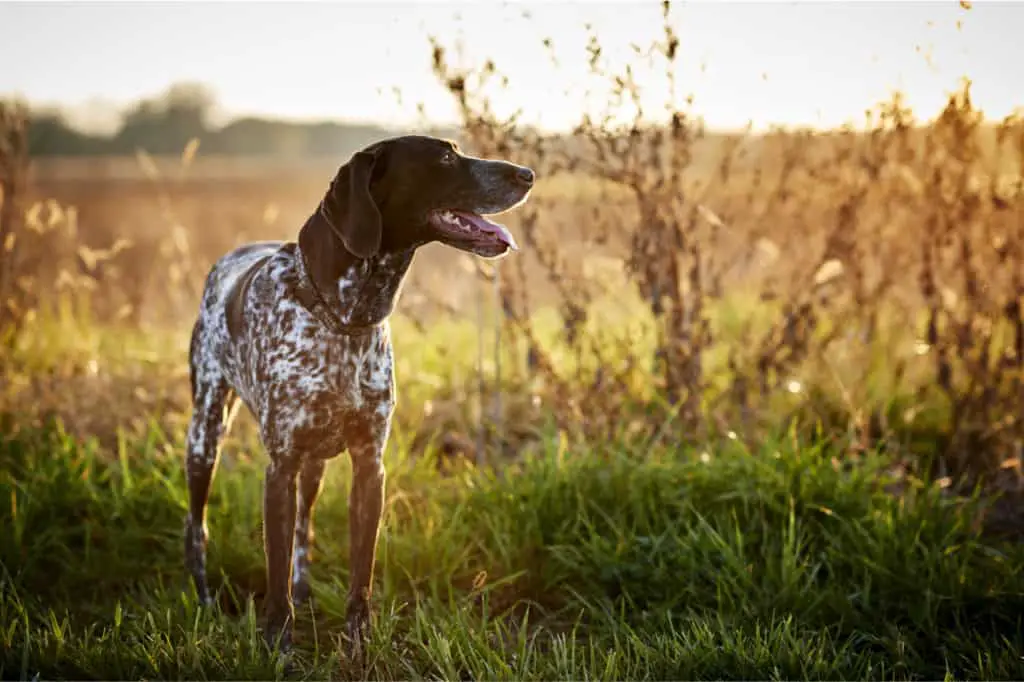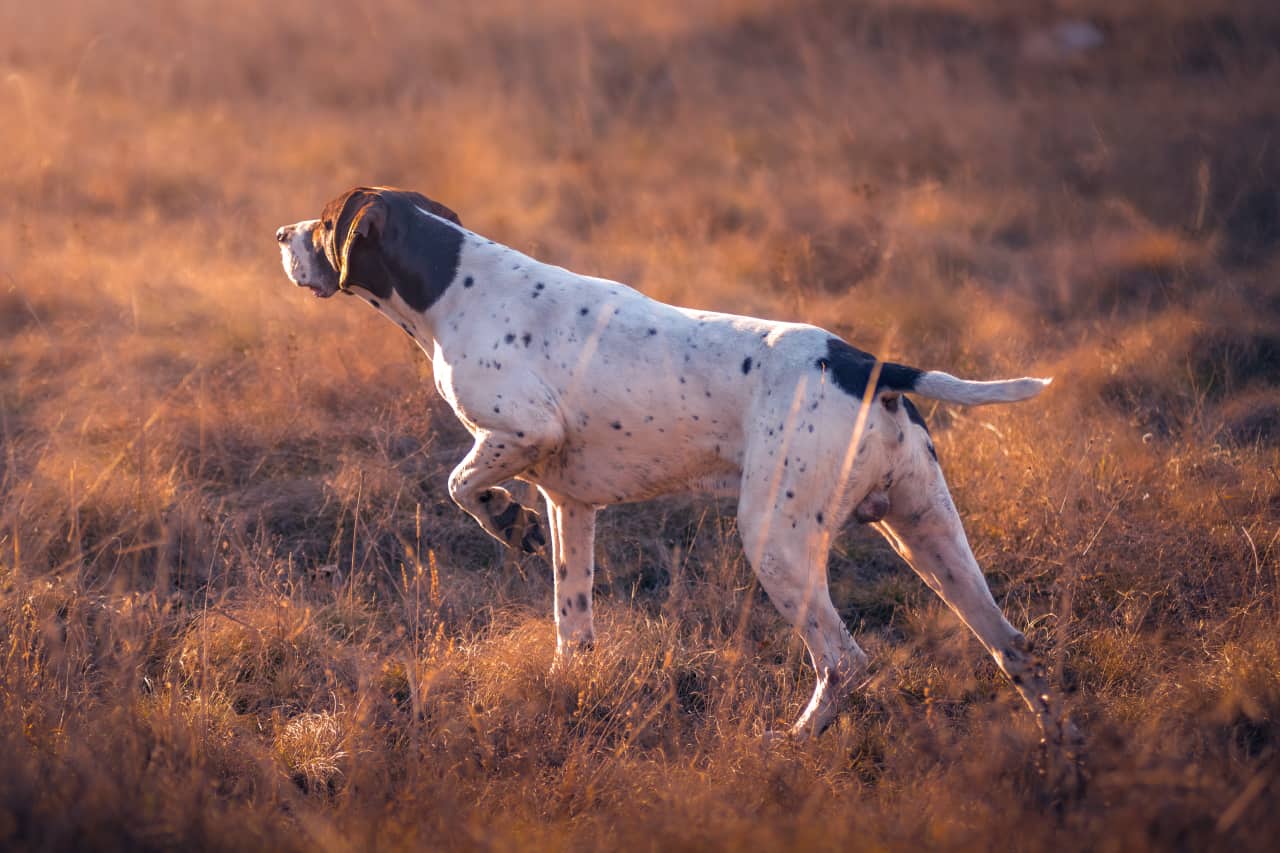German Shorthaired Pointers (GSPs) are highly sought after as hunting dogs because they can point, retrieve, and track game of any size, including deer. They are born hunters and, with a little training, can start work before they are even a year old. GSPs take readily to water and rough terrain.
A German Shorthaired Pointer can track deer. Although they are often used as bird dogs, GSPs are versatile gundogs. The breed was created to locate furred and feathered quarry of all sizes. They are reliable, hardy, tireless, and intelligent. GSPs excel at pointing, retrieving, and tracking.
The GSP is a medium to large-sized breed created in 19th century Germany, especially for hunting. They were bred to fulfill all the various roles of a gundog and are classified as a sporting dog. They can trail, retrieve, and point any kind of game, including waterfowl, grouse, and deer.
Is There A Difference Between Trailing and Tracking?
People may wonder if there’s a difference between tracking and trailing. In dog competitions, with scent hounds, they are indeed two very distinct activities. In hunting, some people use the terms interchangeably. Generally speaking –
- Tracking is the dog’s ability to follow a scent trail with his nose to the ground, following each step taken by the quarry until he locates the source.
- Trailing is a dog’s ability to follow a scent trail with his nose to the ground by coursing to determine the direction of travel and to locate the source. Coursing is when the dog runs from side to side.
- Air scenting is the ability of the dog to follow a scent that is in the wind. The dog will lift his head and sniff the air.
Many hunting dogs do all three, but most have a default mode of operation that they prefer. This may affect how they are trained, depending on what they are required to track. German Shorthaired Pointers are natural trackers but are also good at air scenting.
The Nose of a German Shorthaired Pointer
Except for scent hounds, the GSP has arguably the best nose of any dog breed. The German Shorthaired Pointer has outstanding scenting and trailing ability in the field. He holds his large brown nose low to the ground as he follows the scent intently.
GSPs are unusual in that they are silent while trailing a scent. They can run for hours if necessary because they are natural athletes. This makes them good dogs for tracking deer.
A ground scenting dog such as a GSP follows a trail. This need not be just a blood trail but can consist of the scent from the deer’s feet, recently crushed vegetation from its passing through and even the disturbed soil left on its path.
Because of their air scenting ability, GSPs make a great stalker’s dog, as they have a natural tendency to point out unseen deer. However, you need to decide early on if you wish to use one for tracking work as ideally, they should be trained to ground scent first.
A tracking dog needs a moist nose to help its olfactory receptors achieve their full potential. A dog’s ability to pick up and process scent requires the nose’s sensory receptors to be clean and damp. So make sure that your GSP does not have a dry nose.
Using The German Shorthaired Pointer to Track Deer
The use of dogs for tracking deer has become increasingly popular in recent years. GSPs can be trained to track a wounded deer. This is called blood trailing, and good blood trail dogs can tell if a deer is mortally wounded.
GSPs are born trackers and have a strong hunting instinct. There are even stories on hunting forums of German Shorthaired Pointers trained as bird dogs who have been able to find a wounded deer lost by a hunter after it has been shot.
They can also detect the scent of a deer that has not been wounded by air scenting.
Purchasing a German Shorthair Pointed bred from the best tracking lines can be advantageous, but it is not enough. To make a dog great, you must put in the effort. You need to form a strong bond with your dog, so he trusts you implicitly, you must learn to together as a team, and the dog needs the correct training.
GSPs can be invaluable to hunters who have lost a wounded deer.
The deer could take days to die, but you can avoid this cruelty by having a dog that finds it quickly. The idea is to take the dog to the place the deer was standing when you shot it. This gives him the scent, which he will then follow to locate the deer.
When training them initially, you need to teach them to find deer meat or deer hide and track using deer blood. Work the dog in different terrain types such as forests and brushland and reward him with treats or praise when he succeeds at a task.
Deer hunters will often teach a dog to track a deer’s antlers by letting him play with them and then hiding them so he can find them.
When a dog takes up a blood trail, it is called “running the line”. He needs to pick up the start of the track and follow it to the end.

The Temperament of the German Shorthaired Pointer
GSPs are affectionate, active, high-energy dogs that thrive on exercise. They are independent and athletic and can scale a six-foot fence. If they are not kept busy, they will entertain themselves in ways that may not please their owners, including escaping the yard to go off hunting.
They are bred as much for their ability to provide companionship as for their hunting ability. German shorthaired pointers have innate hunting instincts, so training from an early age is essential. Otherwise, they may go off on their own and return with the neighbor’s poultry, rats, pigeons, and even cats.
GSPs are generally friendly dogs that need to spend a lot of time interacting with their humans to reach their full potential.
Generally, they get on well with other dogs if properly introduced and socialized. It is advisable to teach them early on which animals are legitimate prey and which ones are off-limits. German shorthaired pointers should be given training exercises and taught to play fetching and retrieving games from puppyhood.
Some people would rather take their dog to a professional trainer, but this is unnecessary and expensive. In any event, the professional trainers say that the dogs should know basic commands and be adequately socialized before coming to them. They say the owner should do basic obedience training with the dog and teach him to sit, walk on a lead, fetch and retrieve.
Hunting Deer With The German Shorthaired Pointer
These dogs are keen to work and excel at many different sporting activities. GSPs are especially popular in the United States as versatile gun dogs. They have an innate hunting instinct and a sharp nose. A single GSP has been reported to have killed a swimming deer by repeatedly pushing its head down underwater without being taught.
The GSP is bred to make his own decisions out in the field around prey animals while his owner is catching up. As a result, GSPs can be independent thinkers, but few of them are stubborn. When young, they can be distracted during hunting by other intriguing sounds, scents, and sights.
If you want the dog to hunt deer only, then it is recommended that you train him that deer are the only prey animals that he is allowed to hunt. Otherwise, he will see upland birds and waterfowl as fair game.
Many states in America have laws on using dogs for hunting. A few states allow the dog to run free, but most require a leash at all times. Hunters usually put the dog in a vest with a place on the back where a lead is attached.
A few states do not allow you to use dogs to track deer at all, and some states have regulations that don’t allow tracking dogs to bark.
These laws are due to concerns that dog packs will run healthy deer across property lines and disturb other hunters. It is best to check the law in the area you wish to hunt before taking a dog along.
Conclusion
The German Shorthaired Pointer is a versatile gundog that can track many different types of game, including deer. They are bold and courageous and can be trusted to track, point, retrieve, and hunt any size animal. As sporting dogs, they require a great deal of exercise, so their owners should also have high energy levels to keep up with their needs.

